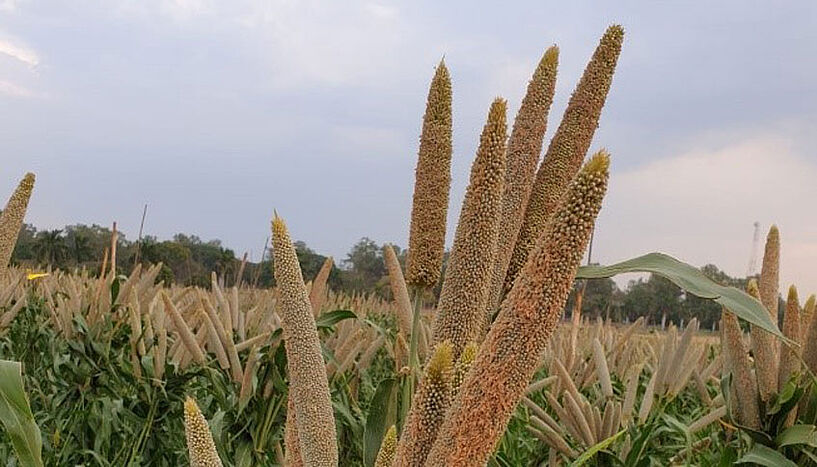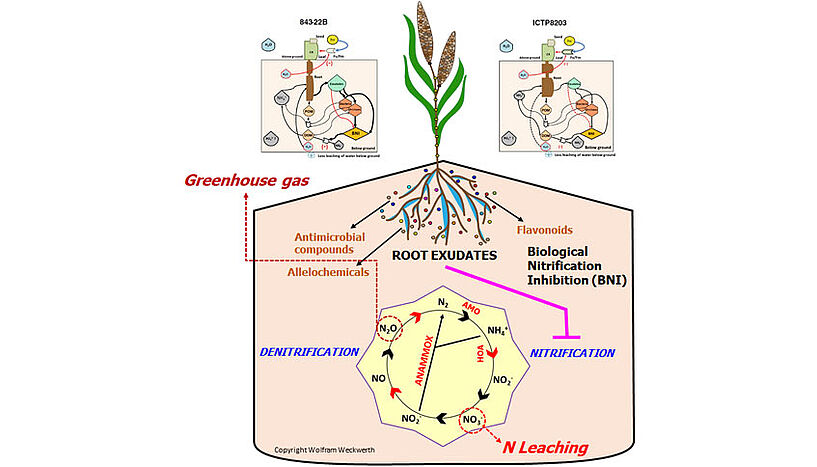Root exudation and biological nitrification potential in pearl millet can boost sustainable agriculture
21. Juli 2021Agriculture is the main source for the majority of the input of reactive N to terrestrial systems; large amounts of fertilizer N are lost from the root zone as nitrate through leaching and denitrification. Avoiding the combination of high external inputs with low resource use efficiency remains a major concern for the sustainability of N in agroecosystems. A group of international scientists from Molecular Systems Biology (MOSYS) Lab, Vienna Metabolomics Center (VIME) team from University of Vienna, Austria, CEGSB team ICRISAT, India and JIRCAS, Tsukuba, Japan, has demonstrated that root exudation of contrasting drought-stressed pearl millet genotypes conveys varying biological nitrification inhibition (BNI) activity. It explains how pearl millet genotypes can induce belowground modification to survive under stress conditions and preserve productivity in the arid region.
Wolfram Weckwerth, lead of the study, highlights the importance, "this study provides the first evidence of genotypic differences in the BNI-capacity of pearl millet where BNI release is substantially influenced by drought stress". He further explains "Plants under drought stress are subject to microclimatic changes in their soil habitat. Consequently, partial pressure of oxygen and the redox potential in the soil is increased. These changes accelerate nitrification and decelerate denitrification by the enzymatic activity of microorganisms (BNI) or simple chemical redox processes in the soil. Plants can buffer these oxidation processes and protect the vital ammonium resource by exuding oxidizable phenolic compounds via their roots". He further added," here, we put forward an ecological functionality for Pennisetum root exudation. We observed a genotype-specific relation of elongated root growth trait with root exudation and possible impact on the BNI activity under drought stress".
Arindam Ghatak from Molecular Systems Biology (MOSYS) Lab highlighted the importance of analytical platforms such as HPLC-UV, GC-MS, and LC-MS to characterize the root exudates. Furthermore, the systematic application of multiomics in collecting and analyzing root exudates will provide a deeper understanding of the belowground plant-soil interactions under abiotic stress to enhance plant productivity and quality. It also provides a unique fingerprint for a trait that can be useful for predicting phenotypic properties.
Our pace of understanding the influence of plant root exudates on nitrification and identification of BNI compounds promises to improve agronomic NUE in crop plants and mitigate agriculturally produced N pollution, which causes eutrophication N2O emissions. Future development of BNI-enabled crops such as pearl millet through molecular exploitation of BNI-trait or physiological traits will be critical for transforming the high-nitrifying, nitrogen-leaking production systems to low-nitrifying and low-N2O emitting agriculture lands.
Publication in "Biology and Fertility of Soils":
Ghatak A., Schindler F., Bachmann G. et al. (2021) Root exudation of contrasting drought-stressed pearl millet genotypes conveys varying biological nitrification inhibition (BNI) activity. Biol Fertil Soils.
DOI: 10.1007/s00374-021-01578-w
Wissenschaftlicher Kontakt
Univ.-Prof. Dr. Wolfram Weckwerth
Department für Funktionelle und Evolutionäre ÖkologieUniversität Wien
1090 - Wien, Althanstraße 14 (UZA I)
+43-1-4277-765 50
+43-664-60277-765 50
wolfram.weckwerth@univie.ac.at
Rückfragehinweis
Mag. Alexandra Frey
Media Relations ManagerUniversität Wien
1010 - Wien, Universitätsring 1
+43-1-4277-17533
+43-664-8175675
alexandra.frey@univie.ac.at


